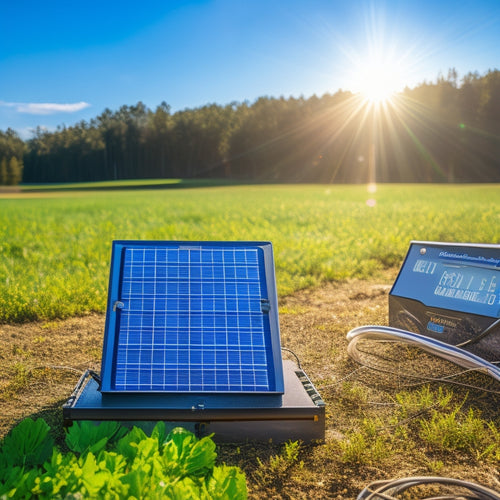
Installing a Power Inverter in Your Vehicle
Share
Installing a power inverter in your vehicle lets you convert the DC battery power into AC power, perfect for charging devices and running small appliances while you're on the go. Start by choosing the correct inverter based on your wattage needs, ensuring the total wattage of your devices doesn't exceed the inverter's continuous rating. After selecting, connect the inverter to your car battery, usually through the cigarette lighter or by direct wiring. This setup not only enhances travel efficiency but also reduces reliance on fuel-powered generators. To maximize your experience, you might want to investigate more about the specific installation steps and compatible devices.
At a Glance
-
Choose a suitable inverter based on your power needs, ensuring it can handle the total wattage of the devices you plan to use.
-
Locate an appropriate installation site in your vehicle, ideally near the battery and with sufficient ventilation for heat dissipation.
-
Connect the inverter's positive and negative leads to the vehicle battery, securing them tightly to prevent accidental disconnections.
-
Ensure all wiring is safely routed away from moving parts and high-temperature areas to avoid damage or hazards during operation.
-
Test the inverter by plugging in devices to confirm proper functionality and check for any overheating or unusual sounds.
Convenience for Road Trips
Having a power inverter installed in your vehicle enhances convenience during road trips by allowing you to charge devices on-the-go.
This is particularly useful for those who rely on energy independence through renewable innovations while traveling. You can easily power small appliances, making your travel experience more comfortable and efficient.
This capability guarantees that you stay connected and can use essential equipment without relying solely on battery power.
Charging Devices On-the-Go
When you're on a road trip, the convenience of charging devices on-the-go can't be overstated. With a power inverter installed in your vehicle, you can convert your car into a hub of portable power. This modification not only keeps your devices charged but also enhances your travel experience by ensuring that you're always connected.
Here's a quick reference of common devices you can charge with a power inverter:
| Device Type | Power Requirement (W) | Estimated Charging Time |
|---|---|---|
| Smartphone | 5-20 | 1-2 hours |
| Tablet | 10-30 | 2-4 hours |
| Laptop | 30-100 | 2-3 hours |
| GPS/Other Gadgets | 5-15 | 1-2 hours |
Powering Small Appliances
Powering small appliances during road trips can greatly enhance your travel experience, making it more comfortable and convenient. With the right power inverter, you can run devices like coffee makers, mini-fridges, or laptops directly from your vehicle's battery.
Understanding appliance compatibility is essential; guarantee the inverter's output matches your appliance's requirements to avoid damage or inefficiency.
When selecting a power inverter, consider the types available. Modified sine wave inverters are typically cheaper but may not work well with sensitive electronics.
Pure sine wave inverters, while more expensive, deliver cleaner power and are suitable for a wider range of appliances.
Check the wattage of your appliances; this determines the inverter size you'll need. For instance, a standard coffee maker might require around 600 watts, while a mini-fridge could need up to 100 watts.
Always factor in some extra power capacity to accommodate surges when appliances start.
Enhanced Device Charging Capability
Installing a power inverter in your vehicle greatly expands your charging options.
With the right setup, you can efficiently use power from your solar system to charge devices, making it an excellent complement to RV solar panel kits that provide energy independence.
You can power multiple devices simultaneously, from smartphones to larger appliances, enhancing your road experience.
This versatility guarantees that you stay connected and charged, no matter where your trip takes you.
Increased Charging Options
A power inverter greatly improves your vehicle's charging capabilities, allowing you to efficiently power multiple devices on the go. With this added versatility, you can keep your gadgets charged, guaranteeing you're always connected during your travels. Whether you're on a road trip, camping, or simply commuting, the increased charging options make your life easier.
Here's a quick overview of common devices you can charge with a power inverter:
| Device Type | Power Requirement | Charging Time |
|---|---|---|
| Smartphones | 5-20 Watts | 1-2 hours |
| Laptops | 30-100 Watts | 2-4 hours |
| Small Appliances | 150-300 Watts | Depends on usage |
When installing a power inverter, always observe safety precautions to prevent damage or hazards. Make certain to follow installation tips to guarantee peak performance and longevity. By taking these measures, you'll maximize your inverter's potential and enjoy the freedom to charge your devices wherever you go. Accept the convenience of enhanced charging options, and enjoy the peace of mind that comes with being prepared for any situation.
Versatile Appliance Compatibility
The ability to charge multiple devices is just one of the many benefits of having a power inverter installed in your vehicle. With a power inverter, you can convert your vehicle's DC power into AC power, allowing you to use various appliance types that typically require a wall outlet.
This versatility means you can charge laptops, tablets, smartphones, and even run small kitchen appliances or power tools while on the go.
When choosing a power inverter, consider the power types you'll need. Inverters are available in different wattages, so verify you select one that can handle the total wattage of the devices you plan to connect.
For instance, a 300-watt inverter might be sufficient for charging a couple of phones, while a 1000-watt inverter would be necessary for running a mini-fridge or power-hungry equipment.
Additionally, look for inverters with multiple outlets and USB ports to maximize your charging capabilities. This way, you can keep all your devices powered simultaneously, making your road trips and outdoor excursions more enjoyable and hassle-free.
With the right setup, you'll welcome the freedom to charge and use your favorite appliances wherever the road takes you.
Power Output Capacity Options
When selecting a power inverter for your vehicle, understanding inverter wattage ratings is essential.
You'll need to choose the right size based on the total power demands of your devices. This guarantees that your inverter can handle the load without risk of overheating or failure.
Additionally, evaluating energy storage systems can help you understand how to maximize power efficiency while on the go.
Properly sizing your inverter not only enhances performance but also contributes to a more sustainable energy use in your vehicle.
Inverter Wattage Ratings
Understanding inverter wattage ratings is vital for selecting the right power inverter for your vehicle. Wattage ratings indicate the maximum power output your inverter can provide, which directly affects its ability to run various devices.
You'll typically encounter two key ratings: continuous wattage and peak wattage. Continuous wattage refers to the sustained power your inverter can supply, while peak wattage is the short-term burst of power needed to start devices.
Consider your devices' combined wattage requirements, ensuring that the inverter's continuous wattage rating comfortably exceeds this total. Factor in inverter efficiency, as this will influence how much power is drawn from your vehicle's battery. Higher efficiency means less energy wasted during conversion, enabling you to run devices longer without draining your battery excessively.
Inverter safety is vital; using an inverter with an inadequate wattage rating could result in overheating or damage to your devices. Always choose an inverter that not only meets your power needs but also incorporates built-in safety features, such as overload protection.
Choosing the Right Size
Selecting the right size for your power inverter is essential to guarantee it meets your specific energy needs without risking performance issues.
First, determine your power requirements by calculating the total wattage of the devices you plan to run simultaneously. This includes laptops, phones, and any other electronics.
Inverter types vary, with options like modified sine wave and pure sine wave. Generally, pure sine wave inverters are more efficient and suitable for sensitive electronics, while modified sine wave inverters are adequate for less demanding devices.
When choosing the inverter, consider a model with a power output capacity that exceeds your calculated needs by about 20-30%. This buffer helps accommodate startup surges from appliances like refrigerators or power tools, ensuring reliable performance.
Additionally, always check your vehicle's battery capacity and alternator output to prevent draining your battery or overloading your system.
Selecting Based on Wattage Requirements
To select the right power inverter, start by determining the wattage needs of the devices you plan to use.
Consider the total wattage required for both continuous and surge power, especially for devices that may draw more power at startup.
Make certain the inverter's output rating meets or exceeds this total wattage requirement. This guarantees efficient operation and prevents potential damage to your devices or the inverter itself.
Additionally, understanding deep cycle battery options can help in selecting an appropriate battery system to support your power needs effectively.
Determine Device Wattage Needs
When planning to install a power inverter in your vehicle, it's vital to accurately determine the wattage needs of the devices you'll be using. This process involves wattage calculations, which guarantee that your inverter can handle the power requirements of your devices without risking damage or malfunction. Begin by checking the power rating on each device, typically found on the label or in the user manual.
To help you visualize this, here's a simple table:
| Device | Wattage Requirement |
|---|---|
| Smartphone Charger | 5-10 Watts |
| Laptop | 50-100 Watts |
| Small Fridge | 100-200 Watts |
Add up the wattage requirements for all devices you plan to run simultaneously. This total will guide you in selecting an inverter that meets your needs while confirming device compatibility. Remember, it's vital not to exceed the inverter's capacity, as this could lead to overheating or failure. By carefully considering your wattage needs, you'll enjoy the freedom of powering your devices safely on the go.
Consider Inverter Output Rating
Understanding the inverter output rating is crucial for guaranteeing your devices operate efficiently and safely. When selecting an inverter, you need to take into account both the continuous wattage and peak wattage ratings. Continuous wattage represents the power the inverter can sustain over time, while peak wattage indicates the maximum power it can provide for a short duration, helping to start devices that require a surge.
Different inverter types, such as modified sine wave and pure sine wave, can also affect how your devices perform. Pure sine wave inverters are ideal for sensitive electronics, requiring stable and clean power, while modified sine wave inverters might suffice for simpler devices.
To determine the right inverter for your needs, first, sum the wattage requirements of all devices you plan to use simultaneously. Then, verify the inverter's continuous wattage rating exceeds this total.
Don't forget to account for any devices with high peak wattage demands, as these may need an inverter with a higher peak rating than you initially anticipated. By carefully evaluating these factors, you can achieve the freedom to power your devices reliably on the go.
Cost-Effective Energy Solution
Installing a power inverter can considerably lower your travel expenses by allowing you to use your vehicle's battery to power various devices.
This setup reduces the need for additional fuel-powered generators or expensive charging options on the road.
Lowering Travel Expenses
In today's economy, finding ways to lower travel expenses is essential for many drivers. Installing a power inverter in your vehicle can greatly contribute to fuel savings and overall budget planning. By providing a reliable source of electricity on the go, you can power devices that would otherwise drain your vehicle's battery or require costly stops for charging.
Imagine powering your laptop or mobile devices directly from your car without relying on gas stations or cafés. This capability can help you streamline your trips, reducing unnecessary detours that lead to fuel consumption. With a power inverter, you can also charge essential equipment for work or leisure, allowing you to maximize your travel efficiency.
Moreover, using a power inverter can facilitate the use of energy-efficient appliances, which further aids in lowering your overall energy costs while traveling.
You'll find that planning your travels with an inverter in mind opens up possibilities for savings that align with your freedom-loving spirit. Accept this cost-effective energy solution, and watch how it changes your travel experience while keeping your budget on track.
Frequently Asked Questions
Can I Install a Power Inverter Myself, or Should I Hire a Professional?
You can tackle the DIY installation if you're confident and have the right tools. However, if you're unsure about the process, seeking professional help guarantees safety and proper functionality without risking damage to your equipment.
What Types of Devices Can I Safely Power With an Inverter?
When you're choosing devices to power, consider the inverter wattage and device compatibility. Common options include laptops, small appliances, and phone chargers. Always check each device's requirements to guarantee efficient and safe operation.
How Do I Maintain My Power Inverter for Optimal Performance?
To maintain your inverter for ideal performance, regularly check connections, keep it clean, and avoid overloading. Following these performance tips can considerably enhance your inverter lifespan, ensuring you enjoy reliable power whenever you need it.
Are There Safety Concerns When Using a Power Inverter in My Vehicle?
When you utilize the power of your vehicle, remember that overheating issues can arise if you exceed the inverter capacity. Always verify proper ventilation and monitor usage to safeguard your journey and keep everything running smoothly.
Will Using a Power Inverter Drain My Vehicle's Battery Quickly?
Using a power inverter can drain your vehicle's battery quickly, depending on the power consumption of connected devices and your battery capacity. Always monitor usage to make certain you don't deplete your battery while enjoying your freedom.
Explore More
Installing a power inverter in your vehicle can greatly improve your travel experience. Did you know that nearly 70% of road trippers rely on electronic devices for direction, entertainment, and communication? By choosing the right inverter, you can guarantee your devices stay charged and ready for use. With various wattage options available, you can select an inverter that meets your specific needs, making it a cost-effective energy solution for all your journeys on the road.
Related Posts
-

Advantages of Solar Generating Systems Over Traditional Energy
Solar generating systems provide several key advantages over traditional energy sources. You'll experience lower long...
-

Designing a Green Roof for Maximum Energy Efficiency
Designing a green roof for maximum energy efficiency involves several key strategies. Start by selecting native, drou...
-

Choosing the Right Solar Power Charge Controller
Choosing the right solar power charge controller is crucial for maximizing energy efficiency and extending battery li...


